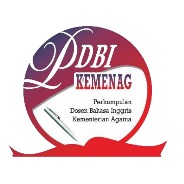Conversational Gambits used by the English Education Program Students of Graduate Program of State University of Padang in Classroom Discussion
Abstract
Full Text:
PDFReferences
Chalak, Azizeh and Norouzi, Zahra. 2014. A Contrastive Analysis of English and Persian Native Speakers’ Use of Gambits. IJRELT, Vol. 1. No. 3, pp: 61-70
Coulmas, Florian. 1981. Rasmus Rask Studies in Pragmatic Linguistics. Vol 2: Conversational Routine. Netherlands: Mouton Publishers
Enciso, Olga Lucia Uribe. 2012. Helping Business English Learners Improve Discussion Skills. Colombian Applied Linguistic Journal. Vol. 14, No. 2, pp: 1-76
Gall, M. Damien and Gillet, Maxwel. 2001. The Discussion Method in Classroom Teaching. http:treeturtle.com/thediscussionmethod.pdf. Retrieved on March 19th, 2014
Keller, E. 1979. Gambits: Conversational Strategy Signals. Journal of Pragmatics. Republished in Coulmas (1981) Rasmus Rask Studies in Pragmatic Linguistics. Vol 2: Conversational Routine. Netherlands: Mouton Publisher
Keller, E and Wanner S. 2002. Conversation Gambits. Real English Conversation Practices. 2nd Ed. Boston: Language Teaching Publication
Miles, M.B. and Huberman, A.M. 1994. Qualitative Data Analysis. 2nd Ed. SAGE Publications. London: International Educational and Professional Publisher
Nikhmer, Amir. 2013. Gambits in a New Light. International Journal of Applied Linguistics & English Literature. Vol. 2, No. 4
Pöhaker, K. 1998. Turn-taking and gambits in intercultural Communication. Instituf für Anglistik . http://archive.ecml.at/documents/.../pdescPenzE2001.pdf. Retrieved on April 1st, 2014
Simensen, A.M. 2010. Fluency: an aim in teaching and a criterion in assessment. Acta Didactica Norge. Vol. 4 Nr.1 Art.2, pp: 1-13
Taslim, Fadila. 2014. “Communication Strategies in Question and Answer in Class Discussion of Second Semester Students at the English Education Program of Graduate Program of State University of Padang”. Unpublished Thesis. State University of Padang: English Education Program
Taylor, Gregory. 2002. Teaching Gambits: The Effect of Instruction and Task Variation on the Use of Conversation Strategies by Intermediate Spanish Students. Foreign Language Annals. Vol. 35, No. 2
Thonbury, Scott and Slade, Diana. 2006. Conversation: From Description to Pedagogy. Cambridge University Press
Wray, A. 2000. Formulaic Sequences in Second Language Teaching: Principle and Practice. In Applied Linguistic, 21/4, pp: 463-489
DOI: http://dx.doi.org/10.29240/ef.v2i2.528
Refbacks
- There are currently no refbacks.
Copyright (c) 2018 Desti Ariani

This work is licensed under a Creative Commons Attribution-NonCommercial-ShareAlike 4.0 International License.
INDEXED BY:
 This work is licensed under a Creative Commons Attribution-NonCommercial-ShareAlike 4.0 International License
This work is licensed under a Creative Commons Attribution-NonCommercial-ShareAlike 4.0 International License
@ ENGLISH FRANCA : Academic Journal of English Language and Education
Jl. Dr. AK Gani No 1 Dusun Curup, Rejang Lebong Regency, Bengkulu Province, Indonesia, 39119.
Dr. Eka Apriani, M.Pd., email: efranca@iaincurup.ac.id, eka.apriani@iaincurup.ac.id.




.png)












